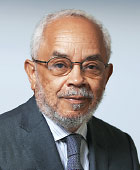I left home on a rainy Sunday afternoon in late September to view “The Ballad of Suzanne Césaire,” a 16 mm film about the French-Caribbean writer and activist, directed by Madeleine Hunt-Ehrlich and screened as part of the New York Film Festival at Manhattan’s Lincoln Center. I was interested because I knew that Suzanne Césaire was the wife of the world-famous Aimé Césaire, a French writer, politician, and public intellectual. However, the film’s screenplay emphasizes that the narrative is about her, not him. Commenting on Suzanne Césaire’s work in Diacritik in 2016, Gabrielle Saïd referred to Césaire’s feminine voice hidden in the shadow behind the solar presence of her husband. Suzanne Césaire has also been called the missing mother of the Negritude movement, as she never received much recognition for its success.
Film notes circulated at the screening depict Hunt-Ehrlich as a visual artist interested in elucidating hidden parts of Black women’s lives. She is concerned that women are often burdened by various gender-based constraints. This partly explains why mere fragments of information exist about Suzanne Césaire’s life story, in comparison to her husband’s international popularity. Hunt-Ehrlich also thinks that, in general, racist and patriarchal structures limit the public spread of Black female artists’ work.
As I watched “The Ballad of Suzanne Césaire,” I wondered about Hunt-Ehrlich’s positionality in relation to the film’s subject, especially when it became obvious that she was committed to creating a story about Césaire from mere fragments of a narrative. Hunt-Ehrlich concedes in the film notes that the task was difficult and Suzanne Césaire well-nigh unknowable.
Imagining the Facts of a Life
I was unprepared for a film that so evidently relied on the director’s imagination to flesh out the factual fragments of a life. It also took me some time to understand that the production would make use of surrealist imagery to strengthen its storyline. One good illustration is a scene that features an actress reading lines from Suzanne Césaire’s work amid a tropical storm. The incongruous juxtaposition of howling winds and rain against the act of reading serious literature evokes her connection to Surrealism. A similar symbolism arises in another scene as the camera focuses on the wind’s scattering of sheets of paper that may represent an unpublished copy of Suzanne Césaire’s work. In addition, we see Césaire in the presence of a male figure I identified as André Breton, the leader of Surrealism. The tableau, ambiguous and provocative, raises questions about its placement and significance.
So, we have an intriguing cinematic tale built on structural fragments and creative imagination. There are other data available from collateral sources. Suzanne Césaire was born in August 1915 on the Caribbean island of Martinique and died in May 1966 in France. She received her early education on the island and went to France in 1933 to study philosophy and literature, first in Toulouse and then in Paris. From 1936 to 1938, she was a student at the prestigious École Normale Supérieure. During her stay in Paris, she met Léopold Senghor, leader of the famous Negritude literary protest movement mentioned earlier, which is said to have been influenced by the Harlem Renaissance of the 1920s and ’30s, especially the work of Langston Hughes and Claude McKay.
Suzanne Césaire also participated in the founding of a journal called L’Étudiant Noir, activity considered fundamental preparation for the literary work that she and her husband took up soon after they returned to Martinique in 1939. While in Paris, she married Aimé Césaire and gave birth to the first of their six children. On their return to the Caribbean, both she and her husband held teaching jobs at local high schools while coediting a cultural and literary revue called Tropiques with René Ménil and Aristide Maugée. Tropiques lasted from 1941 to 1945, and it is in that journal that Suzanne Césaire published seven essays that eventually brought her international fame as a cultural intellectual.
A New Martiniquan Identity
Writing in the International Journal of Surrealism in 2023, María Bernal put Suzanne Césaire at the crossroads of Surrealism, Negritude, and French Caribbean decolonization. Bernal maintains that it was a critical event in 1941 when a cargo ship docked in Fort-de-France with André Breton, Claude Lévi-Strauss, and others who were fleeing war and persecution in Europe. The encounter between artists and writers of the Caribbean and Europe led to the Surrealists’ agreement to join forces with the Martiniquans in their anticolonial struggle. Bernal notes that scholars have discussed this meeting while saying little about Suzanne Césaire’s obvious contribution.
Bernal also points out that Aimé Césaire and René Ménil had a strong interest in cultivating a political role connected to Martinique’s future status in relation to France. They were politicians. On the other hand, Suzanne Césaire wanted to transform the psychology of the Martiniquan population, many of whom had adopted assimilation as their acculturative response to France. She wanted to restore her people’s lost identity with something authentically Black, but not rooted in Africa. No! As Kara Rabbitt framed it in the journal Research in African Literatures in 2008, Césaire wanted to emphasize place, not origin. She had enough of Africa as a source of mythic origins. She was seeking self-acknowledgment. She had confidence in the generational continuity derived from three centuries of contact with the land and people of Martinique.
There was, of course, instability in this new Martiniquan identity. But no matter! It was, for her, grounded in the Antilles, her land. Among the fragments in “The Ballad of Suzanne Césaire” are links to African drums and Negritude, as well as connections to France and to European intellectuals (including Freud). However, Rabbitt confirms that Suzanne Césaire was looking to her freedom as a Martiniquan woman. Césaire also resented the vision of Martinique as a bucolic land waiting to give pleasure submissively. She was interested in political power acquired through generations of women and resting on a new cultural authenticity and recognition of self. ■


